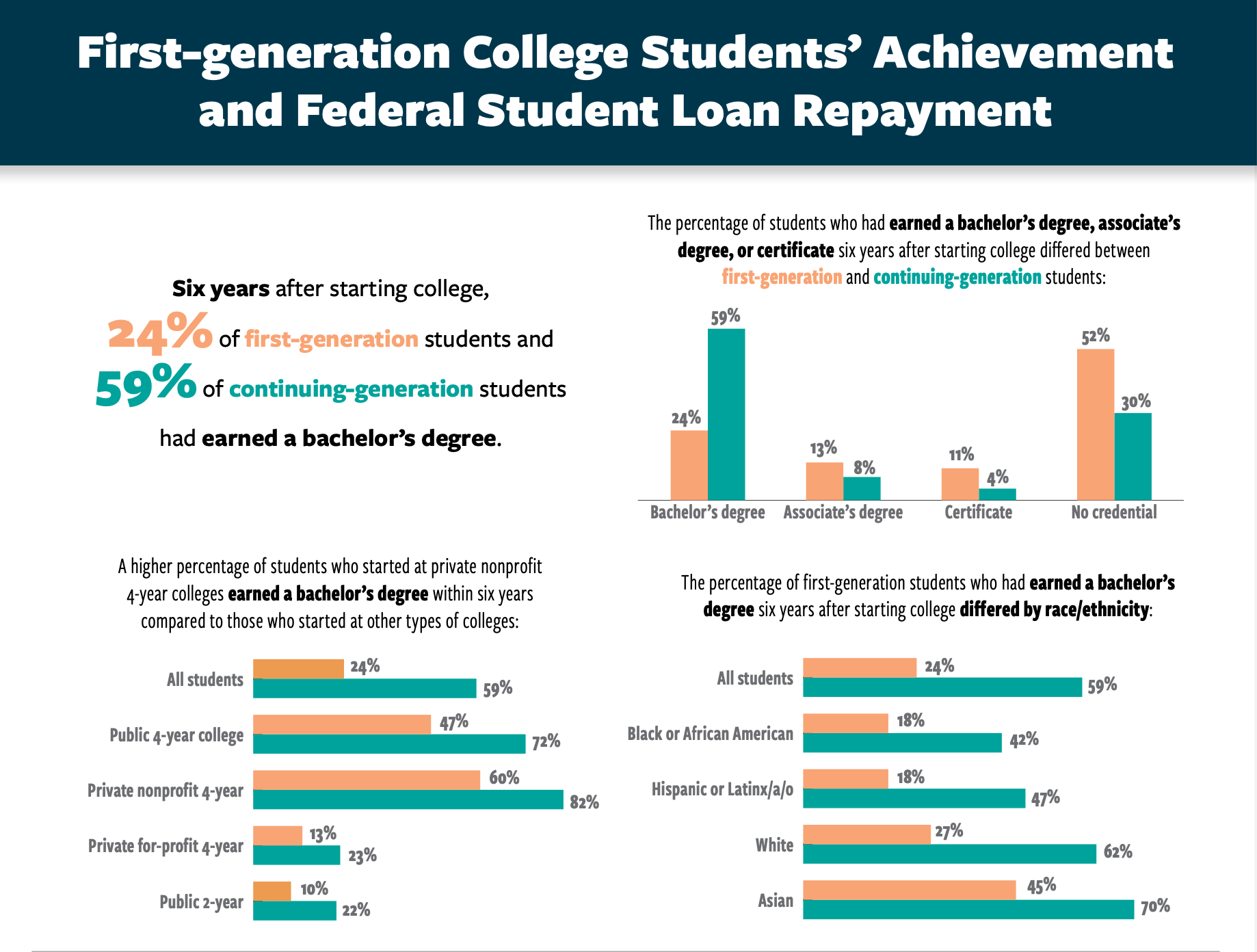Understanding the First-generation Student Identity
Explore the mindset institutions are adopting and the approaches being implemented to improve first-generation student success and completion.
FirstGen Forward is committed to producing dedicated first-generation data and research to the field, allowing for evidence-based decision-making that is critical to first-generation student success— in education, career, and life.
In these fact sheets, the race/ethnicity categories are mutually exclusive. FirstGen Forward recognizes that each racial identity is defined by diverse populations. While aggregation is a useful tool to understand patterns, there are opportunities for continued study to disaggregate the data further. “AI, AN, NH, or PI” is short for American Indian, Alaska Native, Native Hawaiian, or other Pacific Islander. Percentages are rounded.
These fact sheets were produced for FirstGen Forward by RTI International, an independent, nonprofit research institute. The suggested citation for each fact sheet is provided below.
This fact sheet presents statistics about first-generation and continuing-generation students’ degree attainment and federal student loan repayment. The fact sheet represents the six-year outcomes of students who first enrolled in college in academic year 2011–12.

Highlight: Six years after starting college, 24% of first-generation students and 59% of continuing-generation students had earned a bachelor’s degree.
Suggested Citation: RTI International. (2024). First-generation College Students’ Achievement and Federal Student Loan Repayment. Washington, DC: FirstGen Forward. Retrieved from First-generation College Students’ Achievement and Federal Student Loan Repayment
This fact sheet describes first-generation college graduates’ experiences with employment, finances, and additional education four years after they earned a bachelor’s degree. The fact sheet includes median earnings, employer type, and the percentage who enrolled in graduate school.
Produced with support from the Crimsonbridge Foundation
Highlight: 14% of first-generation college graduates and 24% of continuing-generation college graduates had enrolled in a research or professional doctorate program within four years of earning a bachelor’s degree.
Suggested Citation: RTI International. (2024). First-generation College Graduates after Four Years: Employment, Finances, and Additional Education. Washington, DC: FirstGen Forward. Retrieved from https://firstgen.naspa.org/files/dmfile/15405_NASPA_FactSheet-03.pdf
This fact sheet describes first-generation college graduates’ experiences during the COVID-19 pandemic, from 2020 to 2021. The fact sheet includes statistics about failing to meet essential expenses, deferment on private student loans, and taking on additional family or child care, among other difficulties.
Produced with support from the Crimsonbridge Foundation
Highlight: 14% of first-generation college graduates and 8% of continuing-generation college graduates did not meet essential expenses in the previous year because of the COVID-19 pandemic.
Suggested Citation: RTI International. (2024). First-generation College Graduates after Four Years: Experiences during the COVID-19 Pandemic: 2020 to 2021. Washington, DC: FirstGen Forward. Retrieved from https://firstgen.naspa.org/files/dmfile/15405_NASPA_FactSheet-041.pdf
This fact sheet shows the percentage of undergraduate students who were first-generation college students, their parents’ median income, their race/ethnicity, and other selected characteristics. The fact sheet also displays the percentage of undergraduates who were first-generation college students by type of minority-serving institution and by college sector.
Produced with support from the Crimsonbridge Foundation
Highlight: The median income of first-generation students’ parents was $41,000 in both 2016 and 2020, but the median income of continuing-generation students’ parents increased from $90,000 in 2016 to $103,000 in 2020.
Suggested Citation: RTI International. (2023). First-generation College Students in 2020: Demographic Characteristics and Postsecondary Enrollment. Washington, DC: FirstGen Forward. Retrieved from https://firstgen.naspa.org/files/dmfile/15405_NASPA_FactSheet-01.pdf
This fact sheet describes the experiences of first-generation undergraduate students during the early COVID-19 pandemic, from January to June 2020. The statistics shown include the percentage of first-generation students who withdrew from their college, who had difficulty accessing or paying for food, and who received emergency financial assistance through their college.
Produced with support from the Crimsonbridge Foundation
Highlight: Twelve percent of first-generation students and 7 percent of continuing-generation students had difficulty accessing or paying for food as a result of the COVID-19 pandemic.
Suggested Citation: RTI International. (2023). First-generation College Students’ Experiences During the Early COVID-19 Pandemic: 2020. Washington, DC: FirstGen Forward. Retrieved from https://firstgen.naspa.org/files/dmfile/15405_NASPA_FactSheet-02.pdf
These fact sheets provide national statistics about first-generation college graduates’ transition to graduate school and employment in the year after earning a bachelor’s degree. They also show the extent to which first-generation college graduates had used career planning services and participated in extracurricular and co-curricular activities when they were undergraduate students, activities that can help individuals prepare for graduate school and employment. Some statistics are shown separately by race/ethnicity and age. More about this project, including citations and an Issue Brief and Practitioner Guide, can be found here.
These fact sheets provide national statistics about the background characteristics, postsecondary experiences, and outcomes of first-generation and continuing-generation college students in the United States. Detailed information on data collection methods is included with each fact sheet. Scholars and practitioners are encouraged to use these fact sheets to compare national statistics about first-generation students to statistics about first-generation students at their own institution. These fact sheets also provide useful insight to advance research and scholarship specific to first-generation students. More about this project can be found here.